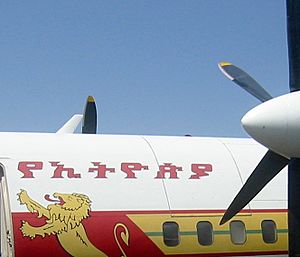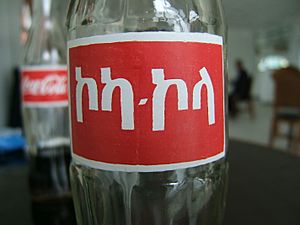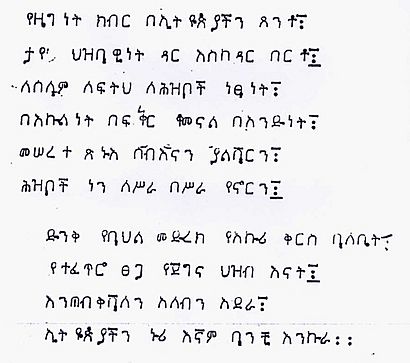Amharic language facts for kids
Quick facts for kids Amharic |
||||
|---|---|---|---|---|
| አማርኛ (Amarəñña) | ||||
Amharic script, fidäl, from Ge'ez script
|
||||
| Native to | Ethiopia | |||
| Ethnicity | Amhara | |||
| Native speakers | 32,000,000 (2018) L2 speakers: 25,000,000 |
|||
| Language family |
Afro-Asiatic
|
|||
| Writing system | Geʽez script (Amharic syllabary) Ge'ez Braille |
|||
| Official status | ||||
| Official language in | ||||
| Regulated by | Imperial Academy (former) | |||
| Linguasphere | 12-ACB-a | |||
|
||||
Amharic (አማርኛ, Amarəñña) is a language spoken mainly in Ethiopia. It belongs to the Semitic family, which is part of the larger Afro-Asiatic language group.
Many people from the Amhara ethnic group speak Amharic as their first language. It is also used as a common language for communication in cities and towns across Ethiopia.
Amharic is the official working language for the Ethiopian government. It is also an official language in several of Ethiopia's regions. About 31.8 million people speak Amharic as their first language. Another 25.1 million people speak it as a second language. This makes Amharic the most widely spoken language in Ethiopia. It is also the second most spoken Semitic language in the world, after Arabic.
Amharic is written from left to right. It uses a special writing system that came from the Geʽez script. This system is called an abugida. In an abugida, each character represents a consonant and a vowel sound together. The characters are known as fidäl (ፊደል), which means "script" or "letter."
There isn't one standard way to write Amharic using the Latin alphabet (like the one English uses). The examples you might see in books often use a system common among experts who study Ethiopian Semitic languages.
Contents
Discovering Amharic's History
Amharic has been very important in Ethiopia for a long time. Since the late 12th century, it has been the official language for government work, courts, trade, and the military. It was even called "language of the king" (Ge'ez: ልሳነ ንጉሥ "Lisane Negus").
Today, Amharic is one of Ethiopia's official languages. Other official languages include Oromo, Somali, Afar, and Tigrinya. Amharic is closely related to Geʽez, an ancient language used in the Ethiopian Orthodox church. The Amharic alphabet is a slightly changed version of the Geʽez alphabet. It has 33 main characters, and each character can have seven different forms depending on the vowel sound.
In 2007, about 21.6 million people in Ethiopia spoke Amharic as their native language. By 2018, this number grew to nearly 32 million. About 25 million more people speak it as a second language. Also, around 3 million Ethiopians living outside Ethiopia speak Amharic.
Amharic is also important to the Rastafari religion. Many followers around the world consider it a holy language.
How Amharic Developed
Experts believe that the Afro-Asiatic language family, which includes Amharic, started a very long time ago. Some think it began in eastern Sahara or southwestern Ethiopia. Over thousands of years, different language groups like proto-Semitic, proto-Cushitic, and proto-Omotic languages developed.
Later, people speaking proto-Semitic languages might have moved from South Arabia to Ethiopia. Evidence from old sites suggests Semitic speakers were in Ethiopia before 500 BC. Language studies even point to their presence as early as 2000 BC.
Amharic is a South Ethio-Semitic language, like Gurage and Harari. Around the 1st century AD, the North and South branches of Ethio-Semitic languages separated. Over time, the Cushitic Agaw people started using the South Ethio-Semitic language. This helped Amharic develop with influences from both Cushitic and Semitic languages.
Amharic also has many words from Geʽez. This happened because the center of the Kingdom of Aksum moved south in the 7th century. This led to more mixing and the spread of Christianity among the proto-Amhara people. Amharic became distinct from its closest relative, Argobba, after the 9th century AD. This was likely due to religious differences, as the Argobba adopted Islam.
Understanding the Writing System

The Amharic writing system is an abugida. Its characters are called fidäl. It comes from a changed version of the Ge'ez script. Each character shows a consonant sound followed by a vowel sound. The basic shape of the character is for the consonant, and it changes slightly for the vowel.
Some consonant sounds can be written in more than one way. This is because these fidäl originally stood for different sounds. But over time, these sounds merged into one. The first column of the fidäl chart shows the basic form for each series, which is the consonant plus the 'ä' sound.
The Amharic script is part of Unicode, which is a standard for computer text. This means you can see and use Amharic characters on most computers and phones.

Amharic Dialects
There isn't a lot of information published about different Amharic dialects. All the dialects can be understood by speakers of other dialects. However, there are some small differences.
Amharic Literature
The oldest known writings in Amharic are from the 14th century. These were poems called "Soldier songs" (የወታደሮች መዝሙር). They praised the emperors and their armies.
Today, there are many types of books and writings in Amharic. This includes government documents, school books, religious texts, novels, and poetry. There are also dictionaries and books on technical and medical topics.
The Bible was first translated into Amharic in the early 19th century by Abu Rumi. Many other translations have been made since then. A very famous Amharic novel is Fiqir Iske Meqabir by Haddis Alemayehu. It was translated into English as Love unto Crypt.
The Rastafari Movement and Amharic
The word Rastafari comes from Ras Täfäri. This was the title of Haile Selassie before he became emperor. Ras means "Head" in Amharic, like a duke. Tafari was his birth name.
Many Rastafarians learn Amharic as a second language. They believe it is a sacred language. After Haile Selassie visited Jamaica in 1966, groups were formed to study Amharic. This helped people explore their African identity and culture.
Some reggae artists in the 1970s, like Ras Michael and The Abyssinians, sang in Amharic. This helped more people learn about the language. For example, the reggae group The Abyssinians used Amharic in their song "Satta Massagana". The title was thought to mean "give thanks." However, it actually means "he thanked" or "he praised." The correct way to say "give thanks" in Amharic is misgana.
Amharic and Computers
Amharic is supported on most major Linux computer systems, such as Fedora and Ubuntu.
The Amharic script is part of Unicode, which helps computers show different languages. The Nyala font on Windows 7 and Vista can display and let you type in Amharic. In 2010, Microsoft released its Windows Vista operating system in Amharic. This allowed Amharic speakers to use their computers in their own language.
Google also added Amharic to its Language Tools. This lets people type in Amharic online even without an Amharic keyboard. Since 2004, Wikipedia has had an Amharic language Wiki that uses the Ethiopic script.
Images for kids
-
Amharic script, fidäl, from Ge'ez script
See also
 In Spanish: Idioma amhárico para niños
In Spanish: Idioma amhárico para niños


